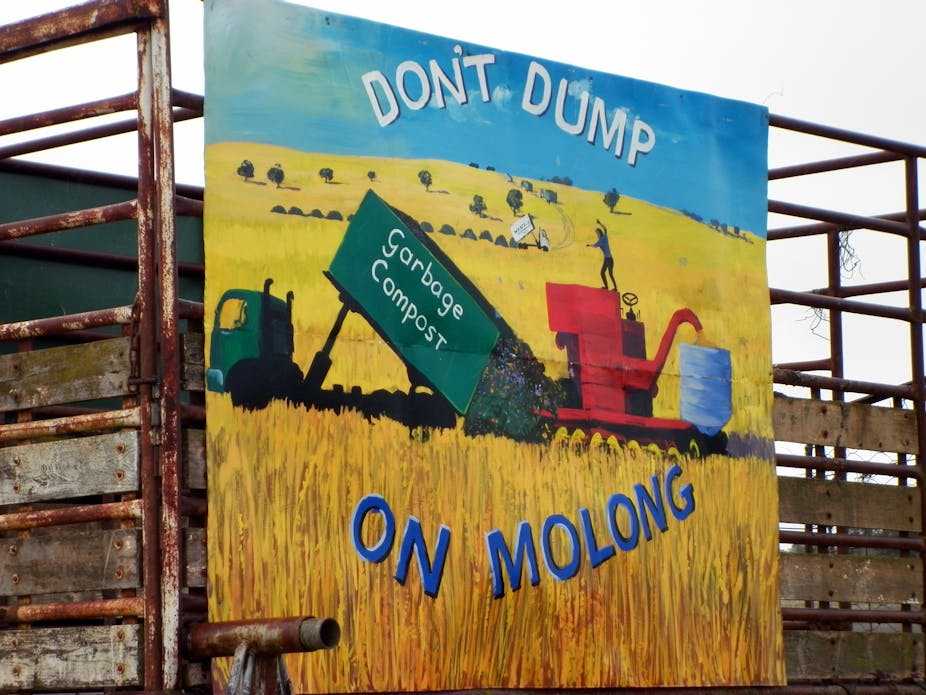Would you classify a landfill for a rural city in New South Wales as state or regionally significant? Should it get a smoother ride through the planning system than other kinds and scales of development? Should it be immunised from local laws which discourage developments with adverse impacts?
Later this month we will find out what the NSW Government thinks. Can NSW get its planning laws in order so they respect local communities, provide a role for independent review, and protect the environment? If so, it will need to wrestle control from the Minister, whose predecessors have used the laws to advance a government-controlled development agenda.
The previous NSW Labor Government thought that a landfill built near the town centre of Molong in country NSW - the Orange Waste Project, which would be a dump for Orange’s rubbish - was regionally significant. It approved the locally controversial development in 2010 under the former Part 3A of NSW’s planning laws. This was despite local planning policy directing that the landfill should not be located on the chosen site and even though the courts had rejected a previous iteration of the development.
The assessment and approval of the Orange Waste Project stands as an illustration of how Part 3A operated at its best and its very worst. It demonstrated how a developer can be encouraged and cajoled into improving the environmental credentials of a development. But it also showed how a local community can have its social, economic and environmental concerns confirmed and supported by local laws, but then found insignificant compared to the presented benefits of a decreed regionally significant project.
Like so many other Part 3A developments, in this project the community was left with nowhere to seek redress despite having a case worth arguing.
The relevant planning policies said the proposed site - which would be used for landfill, composting and recycling - was valuable agricultural land. A permit could not be granted until the decision-maker assessed how the development would affect the present and potential agricultural uses of the land. And the decision-maker had to be satisfied that the landfill wouldn’t have an adverse effect on the long-term use, for sustained agricultural production, of any prime crop-and-pasture land.

The NSW Land and Environment Court overturned an initial approval of the landfill principally on the basis of this policy context. The Court found that the effects of the development would be adverse and long-lasting. On the actual site and in surrounding lands, agricultural uses would be displaced, restricted or put at potential risk.
There was also opposition because the town’s amenity would be affected by rubbish trucks going back and forth from Orange. And more symbolically, the people of Molong did not want their town to be the place where its neighbour’s rubbish, coming from a different local government area, would be dumped.
The developer, the Orange City Council, responded to the court decision by revising its project. It reduced potential environmental impacts and increased sustainable waste practices. Then it presented the tip proposal to the former government as regionally significant under Part 3A.
The Minister for Planning used a broad and practically unchallengeable power to decide that the project was regionally significant. In doing so the geographic scale for the decision-making changed. Local impacts would give way to perceived or potential regional benefits. This was even though the project’s “regionally significant” status was disputed by opponents. The decision was poorly supported by facts and statutory interpretation principles.
What happened next was what happened for over 98% of projects under Part 3A – the Minister approved it. The opponents’ opportunities for appeal were largely and symbolically denied within the planning laws.
We will soon find out what the O'Farrell Government thinks about the importance of certain developments that were previously assessed under the former Part 3A of NSW’s planning law. The NSW Parliament repealed this law shortly after the Coalition Government was voted into office. As part of a review of the NSW planning system, an options paper for reform, and the government’s response to it, are due to be released in June (though the options paper was also promised for April and May, so we shall wait and see).
The paper will certainty include new proposals for identifying, assessing and approving state significant developments. It is important to be able to identify critical and strategic developments warranting State Government oversight. But whether proposals can be framed in a way to pacify ongoing community anger about Part 3A will be interesting to watch.
Can the people of NSW expect meaningful reform? The test will be whether the breadth of the application of the previously laws is severely constrained to projects of true importance to the state. The control previously consolidated in the Planning Minister will have to be reduced and subject to objective standards of good decision-making. And the courts, communities and Parliament must all have defined roles in the new system.
This contribution is based on a presentation on the Orange Waste Project given by the author at the Annual Meeting of the American Association of Geographers in February 2012. A copy of that presentation is available here.

